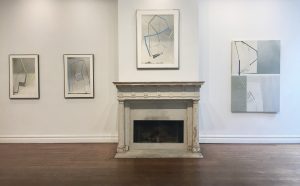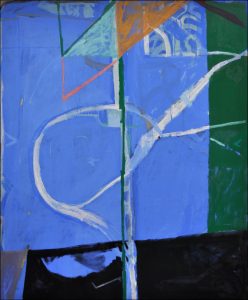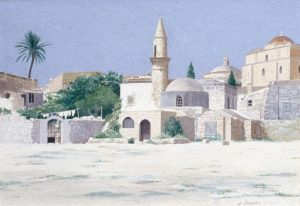Sharon Butler of Two Coats of Paint Interviews Joan Waltemath
In “Fecund Algorithms,” a solo exhibition of new paintings and diminutive sewn-canvas works, Joan Waltemath diverts gently from the quiet perfection of her previous work to embrace small accidents and contingencies. On view at Anita Rogers’s new light-filled second-floor gallery in Soho, Waltemath’s work looks exquisite in the elegantly appointed room, which boasts Greek columns and a long wall of oversized windows facing Mercer Street. Her pristine surfaces and cleanly delineated lines have become scruffier, less refined, and, arguably, more satisfying. A slightly less rigorous approach has yielded interesting insights about spontaneity, uncertainty, and impermanence.
In a conversation at the gallery, I asked the artist about the smudges, scrapes, corrections, and brush strokes that were visible on the surfaces. Waltemath shrugged, suggesting that she feels more comfortable than she used to in leaving residue and mistakes that reveal the process. Elements that she might have corrected or erased now strike her as telling records of the challenges and decisions most painters of geometric shape have to address, concealed or not. Even the tiny black and white pieces made of canvas scraps sewn together by utilitarian machine stitching have an offhand air that evidences Waltemath’s seasoned eye and hand. The painted lines and sewn pieces are not perfect, but here that’s a gift: within essentially mechanical forms, the quirky inconsistencies provide a frisson of humanity.
The paintings, Waltemath told me, also explore the mysteries of human interaction and memory. Lines and shapes painted in subtle ranges of white (impossible to apprehend in JPEG format) deftly organize and occupy the two-dimensional surface of her panels. Upon longer observation, they seem to move, advancing and receding, and creating three-dimensional forms with shifting spatial relationships. From this perspective, Waltemath sees an analogy in the way friendships and other alliances evolve, expanding, contracting, and sometimes reemerging over time. Certainly Waltemath’s new work artfully and unobtrusively, yet very assuredly, reveals its creator’s encounters, thoughtfully marrying content, form, and process.
 es’ precisely organized colors and textures create a prevailing mood of a restful oasis. The sumptuous dilapidation of the gallery walls and fixtures enhance this mood. On a recent trip to Washington D.C. surrounded by historic monuments and nature I felt the same sense of peace and contemplation. These paintings provide the mental space to think, contemplate, and consider. The rigidly organized lines and colors force the consciousness inward or similarly condense the surrounding space and architecture onto a single plane. As such the paintings are correspondingly simple and complex.
es’ precisely organized colors and textures create a prevailing mood of a restful oasis. The sumptuous dilapidation of the gallery walls and fixtures enhance this mood. On a recent trip to Washington D.C. surrounded by historic monuments and nature I felt the same sense of peace and contemplation. These paintings provide the mental space to think, contemplate, and consider. The rigidly organized lines and colors force the consciousness inward or similarly condense the surrounding space and architecture onto a single plane. As such the paintings are correspondingly simple and complex. The collision and/or communion between repetition and randomness in the visual world is a perpetual source of interest for me. Just as what is regarded as “standard” I think of as being too formally familiar. Dichotomy and conflict create inventive dialectic. There is in this world a ubiquitous visual paradox which is a constant source of creative potential. As Oscar Wilde accurately put it: “The true mystery of the world is the VISIBLE not the INVISIBLE”. I wish to go there for a language. – Gordon Moore
The collision and/or communion between repetition and randomness in the visual world is a perpetual source of interest for me. Just as what is regarded as “standard” I think of as being too formally familiar. Dichotomy and conflict create inventive dialectic. There is in this world a ubiquitous visual paradox which is a constant source of creative potential. As Oscar Wilde accurately put it: “The true mystery of the world is the VISIBLE not the INVISIBLE”. I wish to go there for a language. – Gordon Moore The collision and/or communion between repetition and randomness in the visual world is a perpetual source of interest for me. Just as what is regarded as “standard” I think of as being too formally familiar. Dichotomy and conflict create inventive dialectic. There is in this world a ubiquitous visual paradox which is a constant source of creative potential. As Oscar Wilde accurately put it: “The true mystery of the world is the VISIBLE not the INVISIBLE”. I wish to go there for a language.
The collision and/or communion between repetition and randomness in the visual world is a perpetual source of interest for me. Just as what is regarded as “standard” I think of as being too formally familiar. Dichotomy and conflict create inventive dialectic. There is in this world a ubiquitous visual paradox which is a constant source of creative potential. As Oscar Wilde accurately put it: “The true mystery of the world is the VISIBLE not the INVISIBLE”. I wish to go there for a language. Born in Cherokee, IA, Moore received his undergraduate degree from the University of Washington, Seattle in 1970 and then went on to receive his MFA from Yale University in 1972. He has received numerous awards and grants including the National Endowment for the Arts-Visual Artists Fellowship, the Louis Comfort Tiffany Foundation Award in Painting, the Adolph and Ester Gottlieb Foundation Award in Painting, the Academy Award in Art from the American Academy of Arts and Letters, Pollock Krasner Foundation Grant and the New York Foundation for the Arts Fellowship. Moore’s work can be seen in the collections of the Museum of Fine Arts (Boston, MA), Yale University Art Gallery (CT), Baltimore Museum of Art (MD), General Electric Corporation (OH), the Krannert Art Museum (IL) and Kinkead Pavilion (IL).
Born in Cherokee, IA, Moore received his undergraduate degree from the University of Washington, Seattle in 1970 and then went on to receive his MFA from Yale University in 1972. He has received numerous awards and grants including the National Endowment for the Arts-Visual Artists Fellowship, the Louis Comfort Tiffany Foundation Award in Painting, the Adolph and Ester Gottlieb Foundation Award in Painting, the Academy Award in Art from the American Academy of Arts and Letters, Pollock Krasner Foundation Grant and the New York Foundation for the Arts Fellowship. Moore’s work can be seen in the collections of the Museum of Fine Arts (Boston, MA), Yale University Art Gallery (CT), Baltimore Museum of Art (MD), General Electric Corporation (OH), the Krannert Art Museum (IL) and Kinkead Pavilion (IL). London based painter Tristan Barlow is in a two person show with Dutch-born photographer Hans Neleman at Anita Rogers in Soho. Both artists explore processes of accumulation and excavation of cultural imagery and sensual physical substance. Barlow employs layers of marks and shapes that gel into luscious intuitive abstractions that convey a dynamic sense of place. Neleman constructs framed assemblages with great attention to the nuances of mystery and meaning latent in his time-worn found materials and images.
London based painter Tristan Barlow is in a two person show with Dutch-born photographer Hans Neleman at Anita Rogers in Soho. Both artists explore processes of accumulation and excavation of cultural imagery and sensual physical substance. Barlow employs layers of marks and shapes that gel into luscious intuitive abstractions that convey a dynamic sense of place. Neleman constructs framed assemblages with great attention to the nuances of mystery and meaning latent in his time-worn found materials and images.